Evaluating HRM Objectives, Functions & Change Management Theories
VerifiedAdded on 2023/03/23
|19
|4949
|71
Report
AI Summary
This report provides a detailed analysis of Human Resource Management (HRM) objectives and the role of HR functions in contemporary organizations. It covers key areas such as recruitment, training, compensation, and ethical considerations. The report also summarizes different ways HR objectives can be delivered, referencing Ulrich's model, and analyzes how the HR function varies across organizations of different sectors and sizes. Furthermore, it explains major theories of change management, illustrating their application and evaluation. The report also includes a discussion on evaluating the contribution of the HR function to the business using methods like balanced scorecards and benchmarking. Finally, it identifies and evaluates research evidence linking HR practices with positive organizational outcomes, emphasizing the importance of high-performance work practices. Desklib provides access to this and similar solved assignments for students.
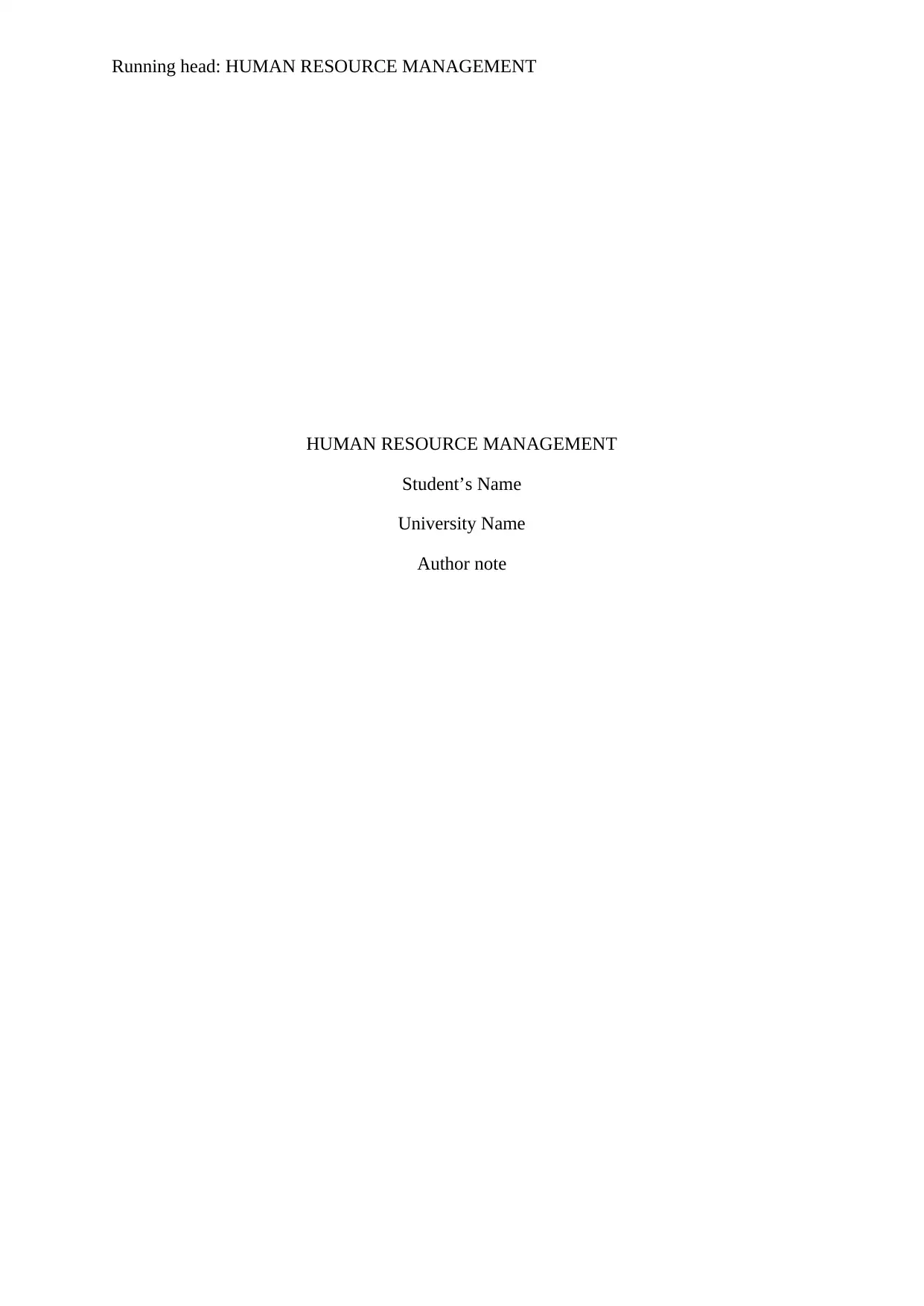
Running head: HUMAN RESOURCE MANAGEMENT
HUMAN RESOURCE MANAGEMENT
Student’s Name
University Name
Author note
HUMAN RESOURCE MANAGEMENT
Student’s Name
University Name
Author note
Paraphrase This Document
Need a fresh take? Get an instant paraphrase of this document with our AI Paraphraser
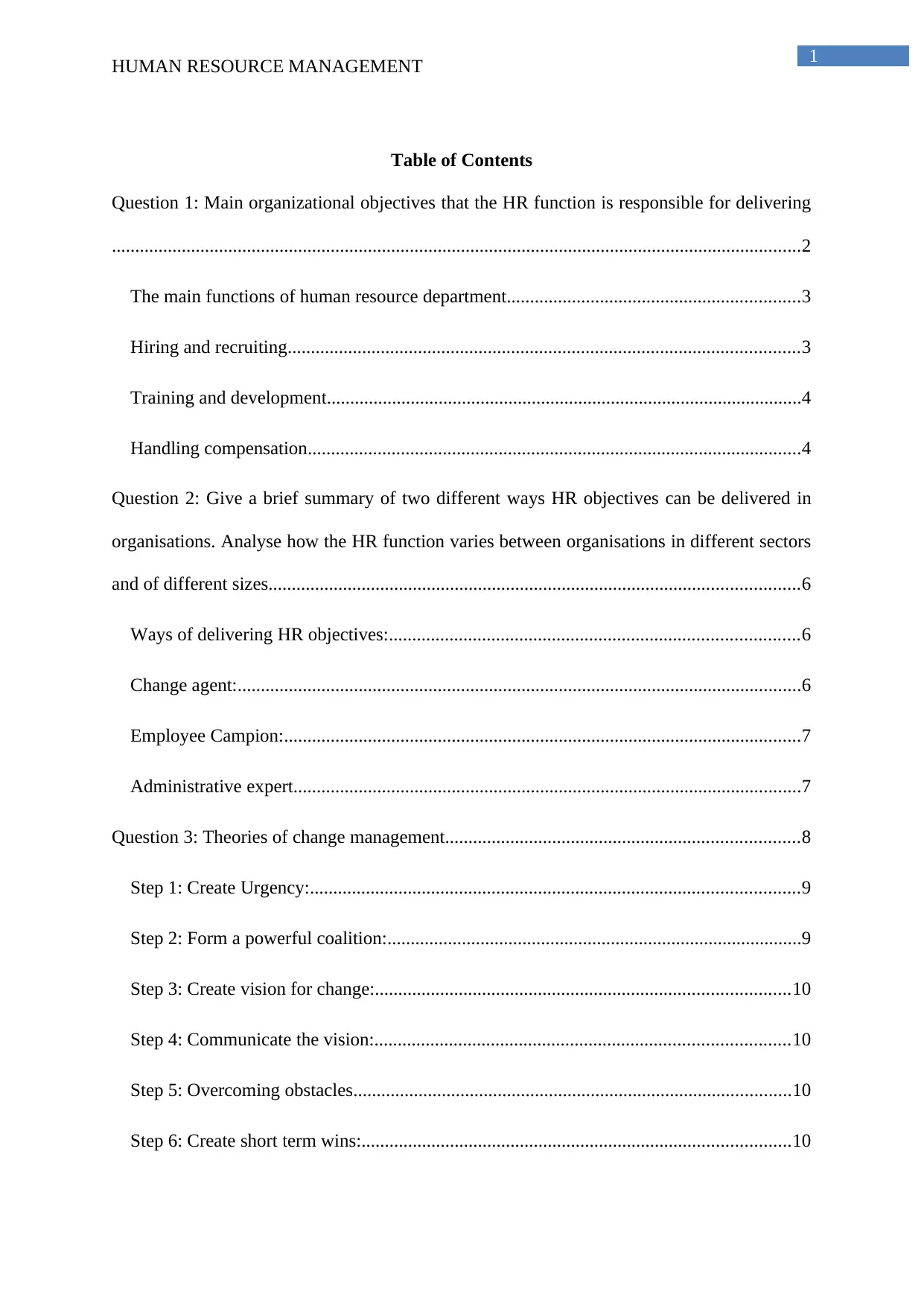
1
HUMAN RESOURCE MANAGEMENT
Table of Contents
Question 1: Main organizational objectives that the HR function is responsible for delivering
....................................................................................................................................................2
The main functions of human resource department...............................................................3
Hiring and recruiting..............................................................................................................3
Training and development......................................................................................................4
Handling compensation..........................................................................................................4
Question 2: Give a brief summary of two different ways HR objectives can be delivered in
organisations. Analyse how the HR function varies between organisations in different sectors
and of different sizes..................................................................................................................6
Ways of delivering HR objectives:........................................................................................6
Change agent:.........................................................................................................................6
Employee Campion:...............................................................................................................7
Administrative expert.............................................................................................................7
Question 3: Theories of change management............................................................................8
Step 1: Create Urgency:.........................................................................................................9
Step 2: Form a powerful coalition:.........................................................................................9
Step 3: Create vision for change:.........................................................................................10
Step 4: Communicate the vision:.........................................................................................10
Step 5: Overcoming obstacles..............................................................................................10
Step 6: Create short term wins:............................................................................................10
HUMAN RESOURCE MANAGEMENT
Table of Contents
Question 1: Main organizational objectives that the HR function is responsible for delivering
....................................................................................................................................................2
The main functions of human resource department...............................................................3
Hiring and recruiting..............................................................................................................3
Training and development......................................................................................................4
Handling compensation..........................................................................................................4
Question 2: Give a brief summary of two different ways HR objectives can be delivered in
organisations. Analyse how the HR function varies between organisations in different sectors
and of different sizes..................................................................................................................6
Ways of delivering HR objectives:........................................................................................6
Change agent:.........................................................................................................................6
Employee Campion:...............................................................................................................7
Administrative expert.............................................................................................................7
Question 3: Theories of change management............................................................................8
Step 1: Create Urgency:.........................................................................................................9
Step 2: Form a powerful coalition:.........................................................................................9
Step 3: Create vision for change:.........................................................................................10
Step 4: Communicate the vision:.........................................................................................10
Step 5: Overcoming obstacles..............................................................................................10
Step 6: Create short term wins:............................................................................................10
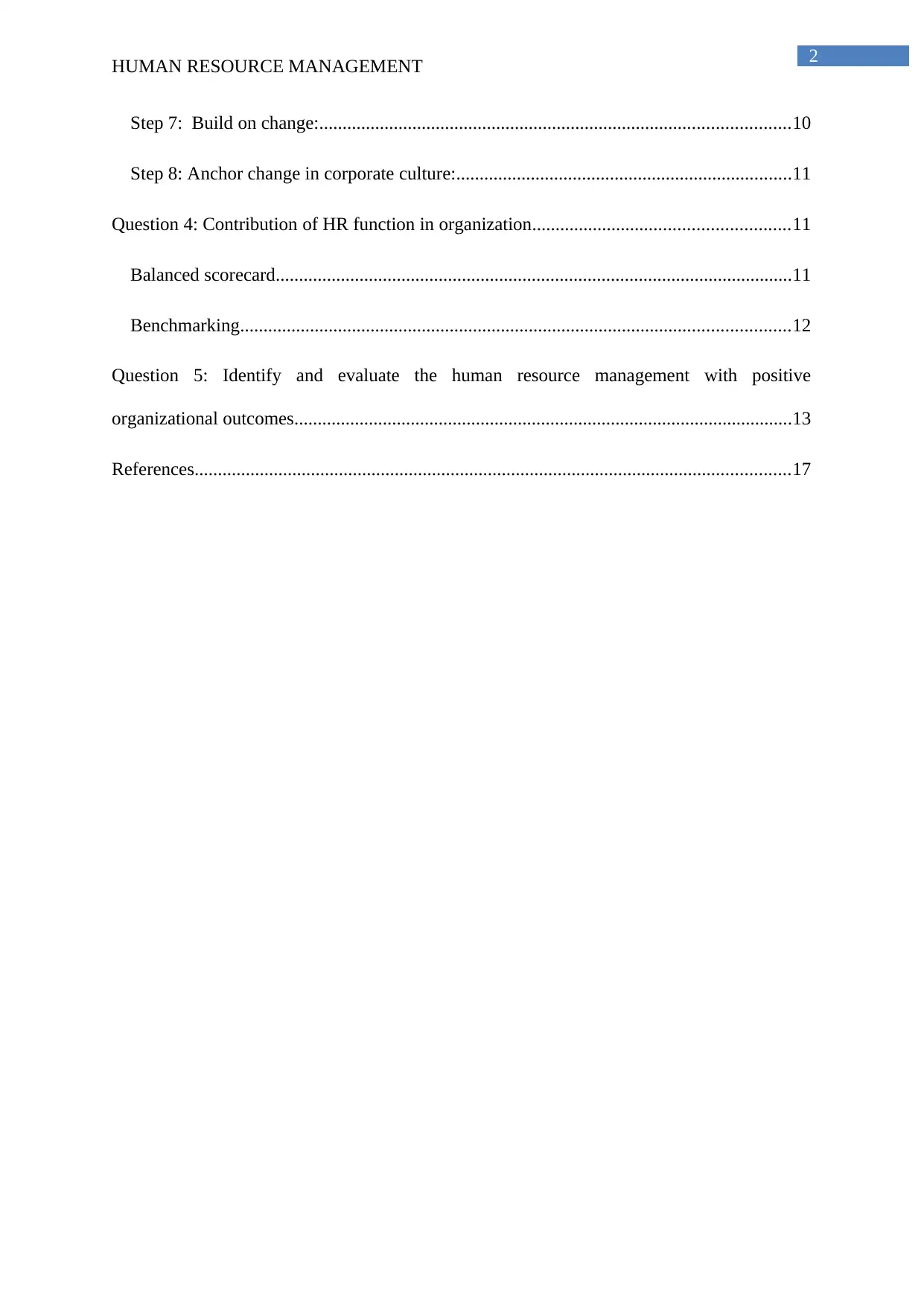
2
HUMAN RESOURCE MANAGEMENT
Step 7: Build on change:.....................................................................................................10
Step 8: Anchor change in corporate culture:........................................................................11
Question 4: Contribution of HR function in organization.......................................................11
Balanced scorecard...............................................................................................................11
Benchmarking......................................................................................................................12
Question 5: Identify and evaluate the human resource management with positive
organizational outcomes...........................................................................................................13
References................................................................................................................................17
HUMAN RESOURCE MANAGEMENT
Step 7: Build on change:.....................................................................................................10
Step 8: Anchor change in corporate culture:........................................................................11
Question 4: Contribution of HR function in organization.......................................................11
Balanced scorecard...............................................................................................................11
Benchmarking......................................................................................................................12
Question 5: Identify and evaluate the human resource management with positive
organizational outcomes...........................................................................................................13
References................................................................................................................................17
⊘ This is a preview!⊘
Do you want full access?
Subscribe today to unlock all pages.

Trusted by 1+ million students worldwide
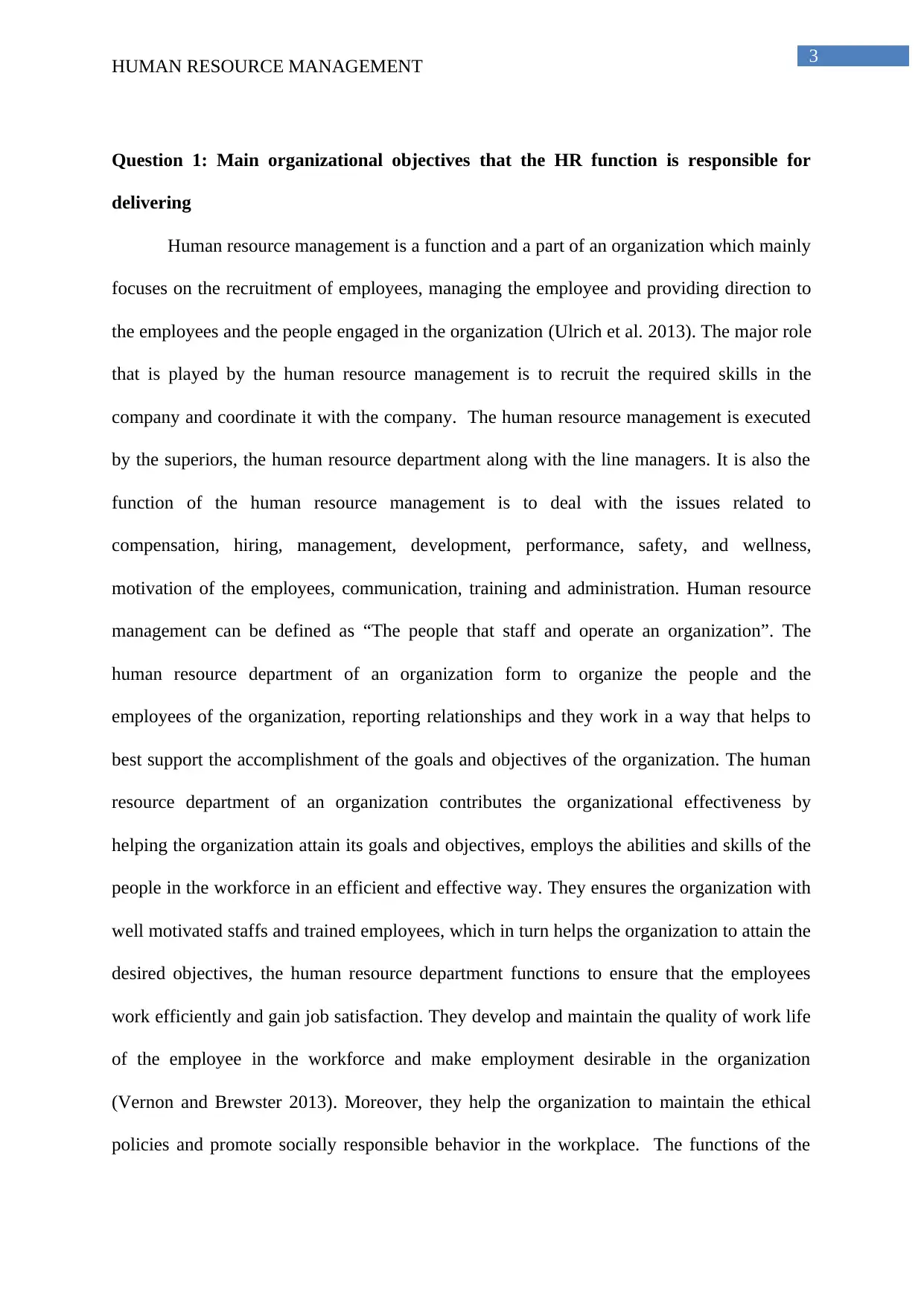
3
HUMAN RESOURCE MANAGEMENT
Question 1: Main organizational objectives that the HR function is responsible for
delivering
Human resource management is a function and a part of an organization which mainly
focuses on the recruitment of employees, managing the employee and providing direction to
the employees and the people engaged in the organization (Ulrich et al. 2013). The major role
that is played by the human resource management is to recruit the required skills in the
company and coordinate it with the company. The human resource management is executed
by the superiors, the human resource department along with the line managers. It is also the
function of the human resource management is to deal with the issues related to
compensation, hiring, management, development, performance, safety, and wellness,
motivation of the employees, communication, training and administration. Human resource
management can be defined as “The people that staff and operate an organization”. The
human resource department of an organization form to organize the people and the
employees of the organization, reporting relationships and they work in a way that helps to
best support the accomplishment of the goals and objectives of the organization. The human
resource department of an organization contributes the organizational effectiveness by
helping the organization attain its goals and objectives, employs the abilities and skills of the
people in the workforce in an efficient and effective way. They ensures the organization with
well motivated staffs and trained employees, which in turn helps the organization to attain the
desired objectives, the human resource department functions to ensure that the employees
work efficiently and gain job satisfaction. They develop and maintain the quality of work life
of the employee in the workforce and make employment desirable in the organization
(Vernon and Brewster 2013). Moreover, they help the organization to maintain the ethical
policies and promote socially responsible behavior in the workplace. The functions of the
HUMAN RESOURCE MANAGEMENT
Question 1: Main organizational objectives that the HR function is responsible for
delivering
Human resource management is a function and a part of an organization which mainly
focuses on the recruitment of employees, managing the employee and providing direction to
the employees and the people engaged in the organization (Ulrich et al. 2013). The major role
that is played by the human resource management is to recruit the required skills in the
company and coordinate it with the company. The human resource management is executed
by the superiors, the human resource department along with the line managers. It is also the
function of the human resource management is to deal with the issues related to
compensation, hiring, management, development, performance, safety, and wellness,
motivation of the employees, communication, training and administration. Human resource
management can be defined as “The people that staff and operate an organization”. The
human resource department of an organization form to organize the people and the
employees of the organization, reporting relationships and they work in a way that helps to
best support the accomplishment of the goals and objectives of the organization. The human
resource department of an organization contributes the organizational effectiveness by
helping the organization attain its goals and objectives, employs the abilities and skills of the
people in the workforce in an efficient and effective way. They ensures the organization with
well motivated staffs and trained employees, which in turn helps the organization to attain the
desired objectives, the human resource department functions to ensure that the employees
work efficiently and gain job satisfaction. They develop and maintain the quality of work life
of the employee in the workforce and make employment desirable in the organization
(Vernon and Brewster 2013). Moreover, they help the organization to maintain the ethical
policies and promote socially responsible behavior in the workplace. The functions of the
Paraphrase This Document
Need a fresh take? Get an instant paraphrase of this document with our AI Paraphraser
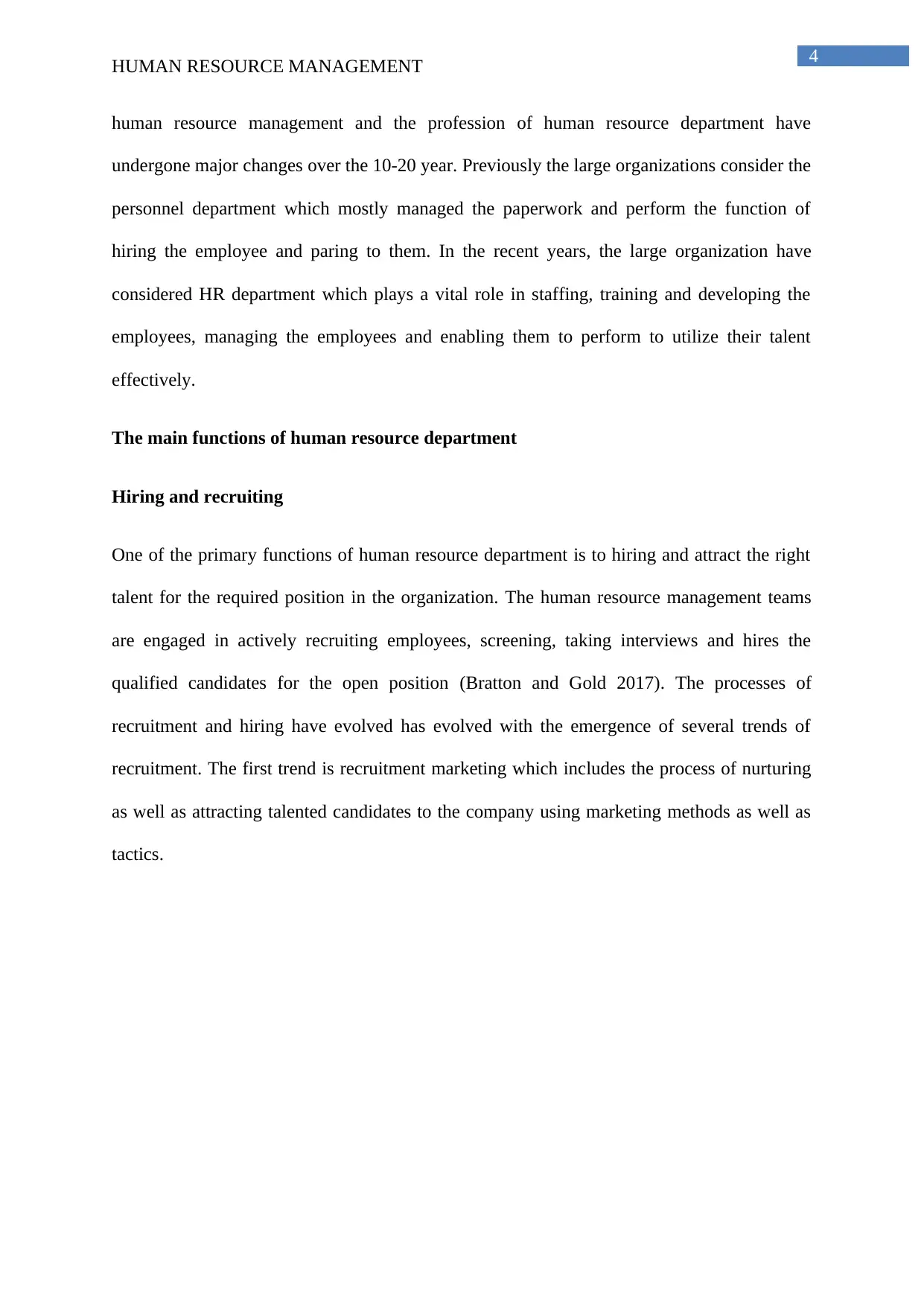
4
HUMAN RESOURCE MANAGEMENT
human resource management and the profession of human resource department have
undergone major changes over the 10-20 year. Previously the large organizations consider the
personnel department which mostly managed the paperwork and perform the function of
hiring the employee and paring to them. In the recent years, the large organization have
considered HR department which plays a vital role in staffing, training and developing the
employees, managing the employees and enabling them to perform to utilize their talent
effectively.
The main functions of human resource department
Hiring and recruiting
One of the primary functions of human resource department is to hiring and attract the right
talent for the required position in the organization. The human resource management teams
are engaged in actively recruiting employees, screening, taking interviews and hires the
qualified candidates for the open position (Bratton and Gold 2017). The processes of
recruitment and hiring have evolved has evolved with the emergence of several trends of
recruitment. The first trend is recruitment marketing which includes the process of nurturing
as well as attracting talented candidates to the company using marketing methods as well as
tactics.
HUMAN RESOURCE MANAGEMENT
human resource management and the profession of human resource department have
undergone major changes over the 10-20 year. Previously the large organizations consider the
personnel department which mostly managed the paperwork and perform the function of
hiring the employee and paring to them. In the recent years, the large organization have
considered HR department which plays a vital role in staffing, training and developing the
employees, managing the employees and enabling them to perform to utilize their talent
effectively.
The main functions of human resource department
Hiring and recruiting
One of the primary functions of human resource department is to hiring and attract the right
talent for the required position in the organization. The human resource management teams
are engaged in actively recruiting employees, screening, taking interviews and hires the
qualified candidates for the open position (Bratton and Gold 2017). The processes of
recruitment and hiring have evolved has evolved with the emergence of several trends of
recruitment. The first trend is recruitment marketing which includes the process of nurturing
as well as attracting talented candidates to the company using marketing methods as well as
tactics.

5
HUMAN RESOURCE MANAGEMENT
The next trend is the emergence of inbound recruiting. This is a marketing strategy for
recruiting whereby the organizations proactively as well as continually attract the candidates
with the goal of making them select the next employer. The last evolution is the emergence of
the employer brand. This implies the development of the organizational reputation as an
employer. In order to attract the potential candidates, the organizations seem to expand their
employee value proposition in context to the development of their image as a general
corporate brand.
Training and development
The human resource department contributes to positive organizational change by
providing them training and development opportunity to enhance the skills and abilities of the
employees to perform better in an organization. It creates training programs and conducts
training for the new recruits and the existing employees in an organization. Enhancement as
well as development of the processes of training and development have vital implications
towards any organization in terms of fulfilling its aim of progressing. Firstly, the modern
methodologies of training and development help in addressing the weaknesses of the
employees. Identification of the areas of weaknesses also helps in elevation of the workers’
HUMAN RESOURCE MANAGEMENT
The next trend is the emergence of inbound recruiting. This is a marketing strategy for
recruiting whereby the organizations proactively as well as continually attract the candidates
with the goal of making them select the next employer. The last evolution is the emergence of
the employer brand. This implies the development of the organizational reputation as an
employer. In order to attract the potential candidates, the organizations seem to expand their
employee value proposition in context to the development of their image as a general
corporate brand.
Training and development
The human resource department contributes to positive organizational change by
providing them training and development opportunity to enhance the skills and abilities of the
employees to perform better in an organization. It creates training programs and conducts
training for the new recruits and the existing employees in an organization. Enhancement as
well as development of the processes of training and development have vital implications
towards any organization in terms of fulfilling its aim of progressing. Firstly, the modern
methodologies of training and development help in addressing the weaknesses of the
employees. Identification of the areas of weaknesses also helps in elevation of the workers’
⊘ This is a preview!⊘
Do you want full access?
Subscribe today to unlock all pages.

Trusted by 1+ million students worldwide

6
HUMAN RESOURCE MANAGEMENT
performance. Other outcomes of the training processes faceted towards the organization are
the ensuring of workers’ satisfaction which helps to increase productivity in the long run.
Increase of employees’ efficiency also implies that there will be a reduction of cost of
operations as well as reduction of the supervisions needs since the surveillance needs of the
organisation will reduce.
Handling compensation
Another main function of human resource department is to take the responsibility of
various aspects of employee compensation. The department handles and manages the payroll
of the employees and pay to them accurately on time. They manage the compensation
programs including pensions and other fringe benefit to the employees that is offered by the
employer(Bratton and Gold 2017). They are also responsible for managing all aspects of
employee benefits such as health and wellness programs.
In today’s context, HR professionals are highly responsible for adding value to the
organizations they are serving for and they contribute to the ethical success of the
organization. They must be managed in an ethical, professional and just manner. They are
responsible for the professional behavior, decisions and actions of the employees in an
organization. They must be engaged in activities which enhance the credibility and value of
the organization. They are to be engaged in professional development, in other words, as HR
professionals they must strive to meet the standards of competence and commit to strengthen
the competencies of the employees on a continuous and regular basis (Brewster 2017).The
HR professional is expected to be an ethical leadership, in other words, they are expected to
exhibit individual leadership. It is important for maintaining the highest standards of ethical
conduct. It is helpful for the organization to carry out its activities in an ethical professional
and in a just manner.
HUMAN RESOURCE MANAGEMENT
performance. Other outcomes of the training processes faceted towards the organization are
the ensuring of workers’ satisfaction which helps to increase productivity in the long run.
Increase of employees’ efficiency also implies that there will be a reduction of cost of
operations as well as reduction of the supervisions needs since the surveillance needs of the
organisation will reduce.
Handling compensation
Another main function of human resource department is to take the responsibility of
various aspects of employee compensation. The department handles and manages the payroll
of the employees and pay to them accurately on time. They manage the compensation
programs including pensions and other fringe benefit to the employees that is offered by the
employer(Bratton and Gold 2017). They are also responsible for managing all aspects of
employee benefits such as health and wellness programs.
In today’s context, HR professionals are highly responsible for adding value to the
organizations they are serving for and they contribute to the ethical success of the
organization. They must be managed in an ethical, professional and just manner. They are
responsible for the professional behavior, decisions and actions of the employees in an
organization. They must be engaged in activities which enhance the credibility and value of
the organization. They are to be engaged in professional development, in other words, as HR
professionals they must strive to meet the standards of competence and commit to strengthen
the competencies of the employees on a continuous and regular basis (Brewster 2017).The
HR professional is expected to be an ethical leadership, in other words, they are expected to
exhibit individual leadership. It is important for maintaining the highest standards of ethical
conduct. It is helpful for the organization to carry out its activities in an ethical professional
and in a just manner.
Paraphrase This Document
Need a fresh take? Get an instant paraphrase of this document with our AI Paraphraser

7
HUMAN RESOURCE MANAGEMENT
Keeping the salaries and benefits competitive, the organization prompts the employees to
loyal to the company and prevents their urge for turnover. Factors like lack of opportunity for
growth, stress as well as overwork and so on are the factors that the organizations need to
take care of in order to ascertain that they are able to retain their best employees.
Question 2: Give a brief summary of two different ways HR objectives can be delivered
in organisations. Analyse how the HR function varies between organisations in different
sectors and of different sizes
According to Ulrich model, developed by David Ulrich suggest that is large scale
business and organizations, the functions of Human Resource should be compartmentalized
into four segments that is strategic partner, change agent, administrative expert and employee
champion. He further stated that shared service and activities along with a supportive
technology which can provide basic support to the business (Ulrich et al. 2013). It suggests
ways to deliver the human resource objectives in its basic principle of creating a unified
structure which helps to deliver value and have a clear distinction and role for the human
resource professions. It creates a competitive edge for the company and is able to measure the
performance of the company as per the metrics. It provides a benchmark for the organization.
Ways of delivering HR objectives:
Strategic partner: the human resource management is currently viewed as a strategic partner
where they perform the function of aligning with the organization. Strategic human resource
considers employees to be an asset for the company that provides competitive advantage to
the organization and leverage the success of the organization (Pollack and Pollack 2015).
This is a new way that is adopted by the companies for handling the employees and making
them prime drivers of corporate success. The organizations considered adopting this way, as
there is high probability for positive results or outcome.
HUMAN RESOURCE MANAGEMENT
Keeping the salaries and benefits competitive, the organization prompts the employees to
loyal to the company and prevents their urge for turnover. Factors like lack of opportunity for
growth, stress as well as overwork and so on are the factors that the organizations need to
take care of in order to ascertain that they are able to retain their best employees.
Question 2: Give a brief summary of two different ways HR objectives can be delivered
in organisations. Analyse how the HR function varies between organisations in different
sectors and of different sizes
According to Ulrich model, developed by David Ulrich suggest that is large scale
business and organizations, the functions of Human Resource should be compartmentalized
into four segments that is strategic partner, change agent, administrative expert and employee
champion. He further stated that shared service and activities along with a supportive
technology which can provide basic support to the business (Ulrich et al. 2013). It suggests
ways to deliver the human resource objectives in its basic principle of creating a unified
structure which helps to deliver value and have a clear distinction and role for the human
resource professions. It creates a competitive edge for the company and is able to measure the
performance of the company as per the metrics. It provides a benchmark for the organization.
Ways of delivering HR objectives:
Strategic partner: the human resource management is currently viewed as a strategic partner
where they perform the function of aligning with the organization. Strategic human resource
considers employees to be an asset for the company that provides competitive advantage to
the organization and leverage the success of the organization (Pollack and Pollack 2015).
This is a new way that is adopted by the companies for handling the employees and making
them prime drivers of corporate success. The organizations considered adopting this way, as
there is high probability for positive results or outcome.

8
HUMAN RESOURCE MANAGEMENT
Change agent:
It is also the responsibility of the department of human resource management to anticipate the
future changes that are most likely to occur in the business environment and it operates, takes
decision to overcome the challenges.
Employee Campion:
The human resource must be the voice of the employees and provide feedback to them.
Implementing this particular model happens by incorporating the objectives of the company
along the various opportunity and challenges that are faced by the company.
Administrative expert
it is the responsibility of the human resource department to implement the procedures and
policies of the HR department and relate to the strategic plan of HR.
The human resource department and the functions of the human resources have
evolved into more strategic contributor for the success of the organization. As compared to
the functions of human resource back in 20 years. In today’s context, the firms have
customized its functions to suit the needs of the company (Pollack and Pollack 2015). Human
resource management is conducted in variety of ways due to the constraints and the strategic
decisions that is taken by the organization to meet the goals and objectives. The functions of
human resource department in specific organizations are unique in most aspects. Every
business organization has a unique functional structure in the staffing role. Some business
organizations combine the responsibilities and roles of the employees with reducing the
wages. Other organizations create unique department which are unique to the production and
service delivery program (Neumeier 2013).The organizations of different sectors and size
determine the roles and functions of the human resource department. Large size organizations
HUMAN RESOURCE MANAGEMENT
Change agent:
It is also the responsibility of the department of human resource management to anticipate the
future changes that are most likely to occur in the business environment and it operates, takes
decision to overcome the challenges.
Employee Campion:
The human resource must be the voice of the employees and provide feedback to them.
Implementing this particular model happens by incorporating the objectives of the company
along the various opportunity and challenges that are faced by the company.
Administrative expert
it is the responsibility of the human resource department to implement the procedures and
policies of the HR department and relate to the strategic plan of HR.
The human resource department and the functions of the human resources have
evolved into more strategic contributor for the success of the organization. As compared to
the functions of human resource back in 20 years. In today’s context, the firms have
customized its functions to suit the needs of the company (Pollack and Pollack 2015). Human
resource management is conducted in variety of ways due to the constraints and the strategic
decisions that is taken by the organization to meet the goals and objectives. The functions of
human resource department in specific organizations are unique in most aspects. Every
business organization has a unique functional structure in the staffing role. Some business
organizations combine the responsibilities and roles of the employees with reducing the
wages. Other organizations create unique department which are unique to the production and
service delivery program (Neumeier 2013).The organizations of different sectors and size
determine the roles and functions of the human resource department. Large size organizations
⊘ This is a preview!⊘
Do you want full access?
Subscribe today to unlock all pages.

Trusted by 1+ million students worldwide
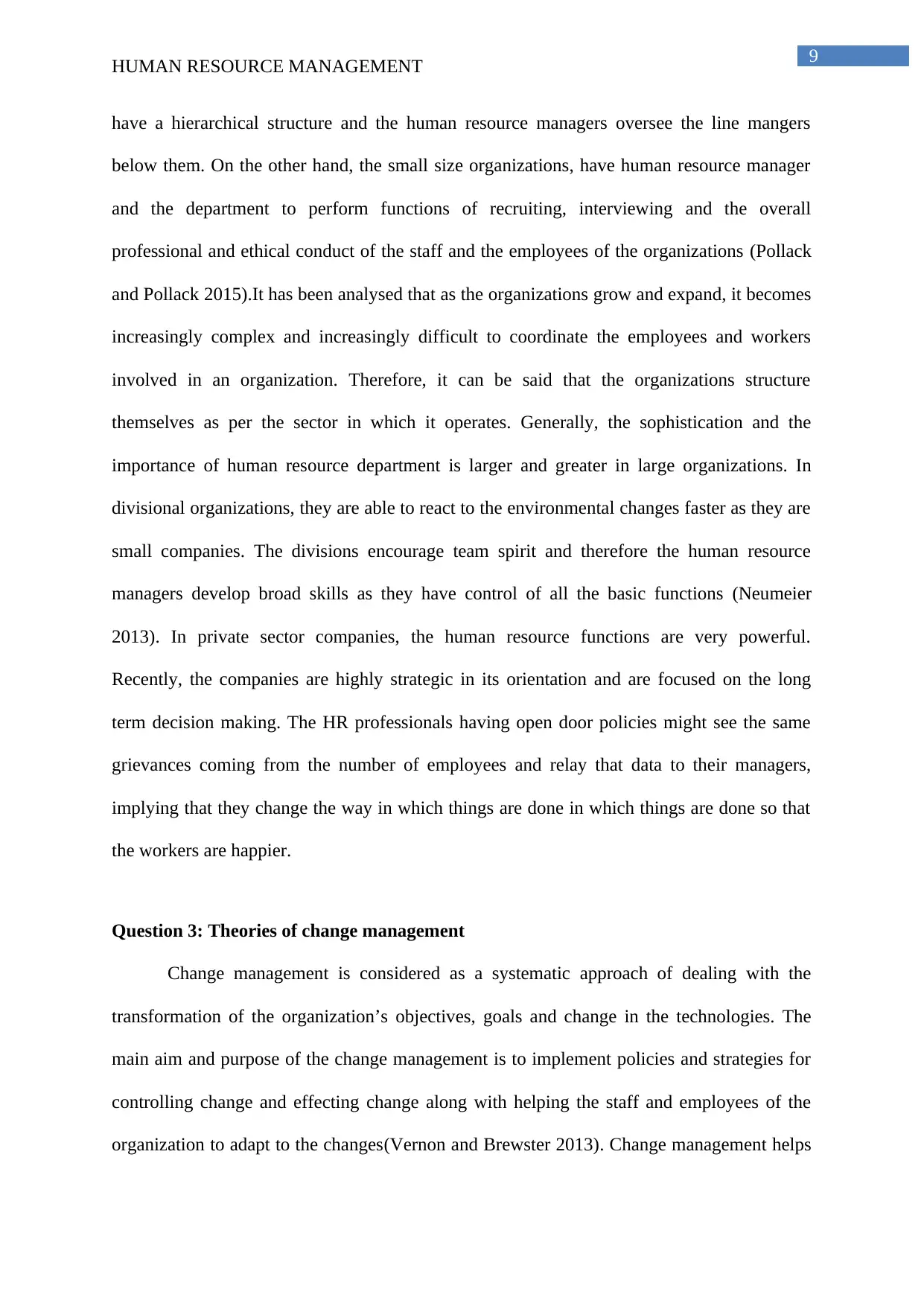
9
HUMAN RESOURCE MANAGEMENT
have a hierarchical structure and the human resource managers oversee the line mangers
below them. On the other hand, the small size organizations, have human resource manager
and the department to perform functions of recruiting, interviewing and the overall
professional and ethical conduct of the staff and the employees of the organizations (Pollack
and Pollack 2015).It has been analysed that as the organizations grow and expand, it becomes
increasingly complex and increasingly difficult to coordinate the employees and workers
involved in an organization. Therefore, it can be said that the organizations structure
themselves as per the sector in which it operates. Generally, the sophistication and the
importance of human resource department is larger and greater in large organizations. In
divisional organizations, they are able to react to the environmental changes faster as they are
small companies. The divisions encourage team spirit and therefore the human resource
managers develop broad skills as they have control of all the basic functions (Neumeier
2013). In private sector companies, the human resource functions are very powerful.
Recently, the companies are highly strategic in its orientation and are focused on the long
term decision making. The HR professionals having open door policies might see the same
grievances coming from the number of employees and relay that data to their managers,
implying that they change the way in which things are done in which things are done so that
the workers are happier.
Question 3: Theories of change management
Change management is considered as a systematic approach of dealing with the
transformation of the organization’s objectives, goals and change in the technologies. The
main aim and purpose of the change management is to implement policies and strategies for
controlling change and effecting change along with helping the staff and employees of the
organization to adapt to the changes(Vernon and Brewster 2013). Change management helps
HUMAN RESOURCE MANAGEMENT
have a hierarchical structure and the human resource managers oversee the line mangers
below them. On the other hand, the small size organizations, have human resource manager
and the department to perform functions of recruiting, interviewing and the overall
professional and ethical conduct of the staff and the employees of the organizations (Pollack
and Pollack 2015).It has been analysed that as the organizations grow and expand, it becomes
increasingly complex and increasingly difficult to coordinate the employees and workers
involved in an organization. Therefore, it can be said that the organizations structure
themselves as per the sector in which it operates. Generally, the sophistication and the
importance of human resource department is larger and greater in large organizations. In
divisional organizations, they are able to react to the environmental changes faster as they are
small companies. The divisions encourage team spirit and therefore the human resource
managers develop broad skills as they have control of all the basic functions (Neumeier
2013). In private sector companies, the human resource functions are very powerful.
Recently, the companies are highly strategic in its orientation and are focused on the long
term decision making. The HR professionals having open door policies might see the same
grievances coming from the number of employees and relay that data to their managers,
implying that they change the way in which things are done in which things are done so that
the workers are happier.
Question 3: Theories of change management
Change management is considered as a systematic approach of dealing with the
transformation of the organization’s objectives, goals and change in the technologies. The
main aim and purpose of the change management is to implement policies and strategies for
controlling change and effecting change along with helping the staff and employees of the
organization to adapt to the changes(Vernon and Brewster 2013). Change management helps
Paraphrase This Document
Need a fresh take? Get an instant paraphrase of this document with our AI Paraphraser
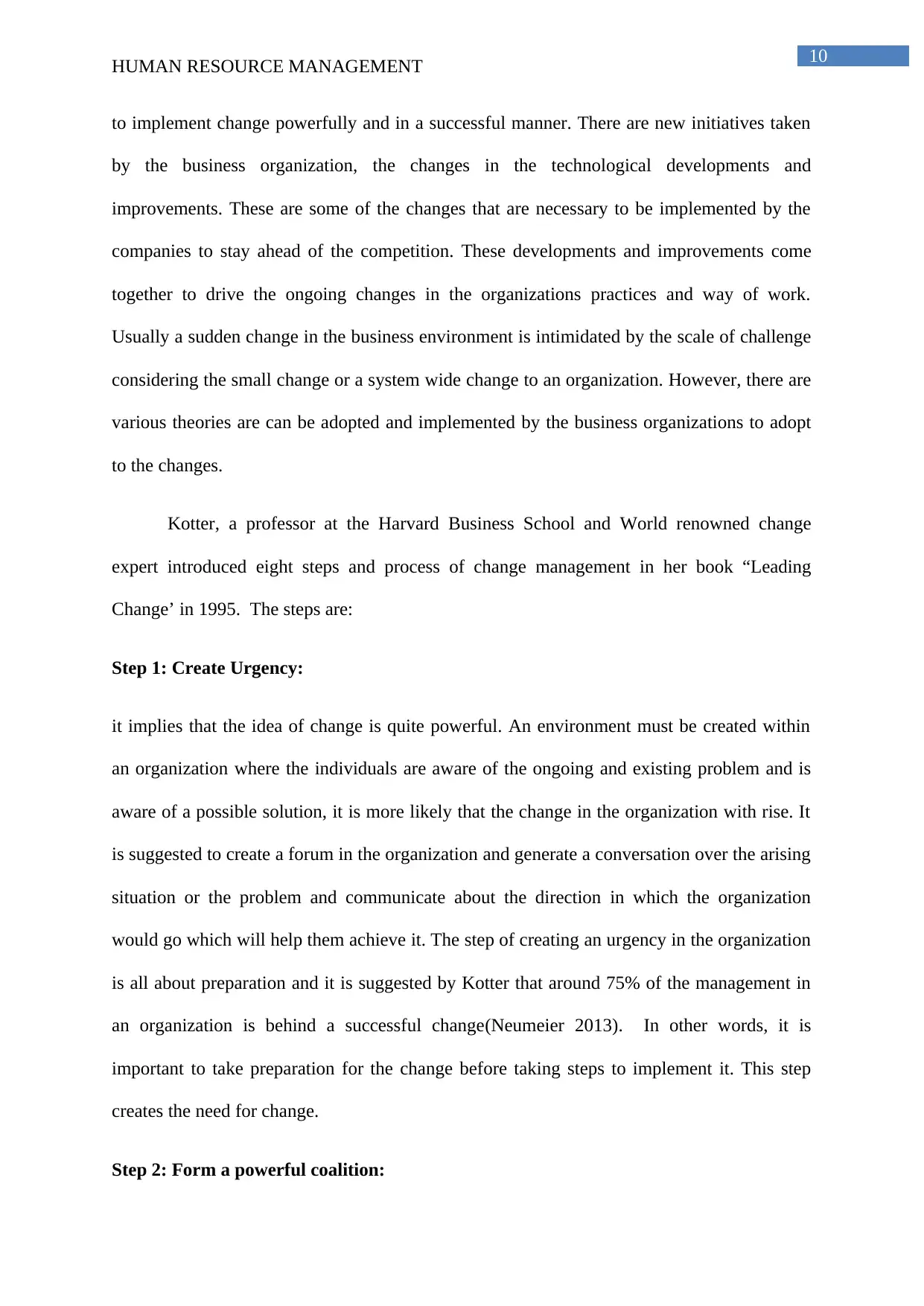
10
HUMAN RESOURCE MANAGEMENT
to implement change powerfully and in a successful manner. There are new initiatives taken
by the business organization, the changes in the technological developments and
improvements. These are some of the changes that are necessary to be implemented by the
companies to stay ahead of the competition. These developments and improvements come
together to drive the ongoing changes in the organizations practices and way of work.
Usually a sudden change in the business environment is intimidated by the scale of challenge
considering the small change or a system wide change to an organization. However, there are
various theories are can be adopted and implemented by the business organizations to adopt
to the changes.
Kotter, a professor at the Harvard Business School and World renowned change
expert introduced eight steps and process of change management in her book “Leading
Change’ in 1995. The steps are:
Step 1: Create Urgency:
it implies that the idea of change is quite powerful. An environment must be created within
an organization where the individuals are aware of the ongoing and existing problem and is
aware of a possible solution, it is more likely that the change in the organization with rise. It
is suggested to create a forum in the organization and generate a conversation over the arising
situation or the problem and communicate about the direction in which the organization
would go which will help them achieve it. The step of creating an urgency in the organization
is all about preparation and it is suggested by Kotter that around 75% of the management in
an organization is behind a successful change(Neumeier 2013). In other words, it is
important to take preparation for the change before taking steps to implement it. This step
creates the need for change.
Step 2: Form a powerful coalition:
HUMAN RESOURCE MANAGEMENT
to implement change powerfully and in a successful manner. There are new initiatives taken
by the business organization, the changes in the technological developments and
improvements. These are some of the changes that are necessary to be implemented by the
companies to stay ahead of the competition. These developments and improvements come
together to drive the ongoing changes in the organizations practices and way of work.
Usually a sudden change in the business environment is intimidated by the scale of challenge
considering the small change or a system wide change to an organization. However, there are
various theories are can be adopted and implemented by the business organizations to adopt
to the changes.
Kotter, a professor at the Harvard Business School and World renowned change
expert introduced eight steps and process of change management in her book “Leading
Change’ in 1995. The steps are:
Step 1: Create Urgency:
it implies that the idea of change is quite powerful. An environment must be created within
an organization where the individuals are aware of the ongoing and existing problem and is
aware of a possible solution, it is more likely that the change in the organization with rise. It
is suggested to create a forum in the organization and generate a conversation over the arising
situation or the problem and communicate about the direction in which the organization
would go which will help them achieve it. The step of creating an urgency in the organization
is all about preparation and it is suggested by Kotter that around 75% of the management in
an organization is behind a successful change(Neumeier 2013). In other words, it is
important to take preparation for the change before taking steps to implement it. This step
creates the need for change.
Step 2: Form a powerful coalition:

11
HUMAN RESOURCE MANAGEMENT
it is important to build a coalition to lead the entire change process to help the management to
direct others in the organization. In order to maximize its effectiveness, coalition must be
build up with a range of skills, experience and people of different areas of the business. It
step is important to spread the messages in all levels of the organization, delegate tasks and
ensure support for the change in the organization wide. Change is more likely to be
successful if the team members complement each other and drive every other member to
work harder(Pollack and Pollack 2015).
Step 3: Create vision for change:
At times it is harder to understand change particularly at the lower level employees of the
hierarchy. Therefore, create a vision for change makes it easier to understand the overall aim
in a useful manner and generating support from the whole organization. The vision for
change must be simple and understandable.
Step 4: Communicate the vision:
The vision that is created in the organization needs to be communicated throughout the
organization. It is important to communicate the message in all the levels of the organization.
Step 5: Overcoming obstacles
The next step is important to build strength of the change initiative and overcome the
obstacles, difficulties and challenges which is likely to reduce the chances for success
(Neumeier 2013). The barriers must be identified and it needs to rely on the available
resources to overcome them without disrupting the other areas of the business.
Step 6: Create short term wins:
HUMAN RESOURCE MANAGEMENT
it is important to build a coalition to lead the entire change process to help the management to
direct others in the organization. In order to maximize its effectiveness, coalition must be
build up with a range of skills, experience and people of different areas of the business. It
step is important to spread the messages in all levels of the organization, delegate tasks and
ensure support for the change in the organization wide. Change is more likely to be
successful if the team members complement each other and drive every other member to
work harder(Pollack and Pollack 2015).
Step 3: Create vision for change:
At times it is harder to understand change particularly at the lower level employees of the
hierarchy. Therefore, create a vision for change makes it easier to understand the overall aim
in a useful manner and generating support from the whole organization. The vision for
change must be simple and understandable.
Step 4: Communicate the vision:
The vision that is created in the organization needs to be communicated throughout the
organization. It is important to communicate the message in all the levels of the organization.
Step 5: Overcoming obstacles
The next step is important to build strength of the change initiative and overcome the
obstacles, difficulties and challenges which is likely to reduce the chances for success
(Neumeier 2013). The barriers must be identified and it needs to rely on the available
resources to overcome them without disrupting the other areas of the business.
Step 6: Create short term wins:
⊘ This is a preview!⊘
Do you want full access?
Subscribe today to unlock all pages.

Trusted by 1+ million students worldwide
1 out of 19
Related Documents
Your All-in-One AI-Powered Toolkit for Academic Success.
+13062052269
info@desklib.com
Available 24*7 on WhatsApp / Email
![[object Object]](/_next/static/media/star-bottom.7253800d.svg)
Unlock your academic potential
Copyright © 2020–2025 A2Z Services. All Rights Reserved. Developed and managed by ZUCOL.





